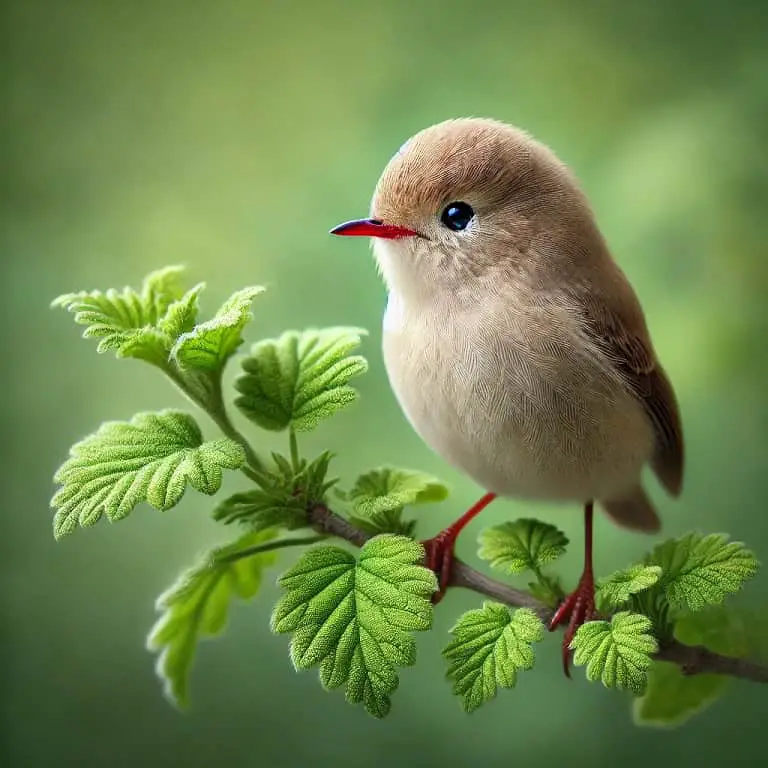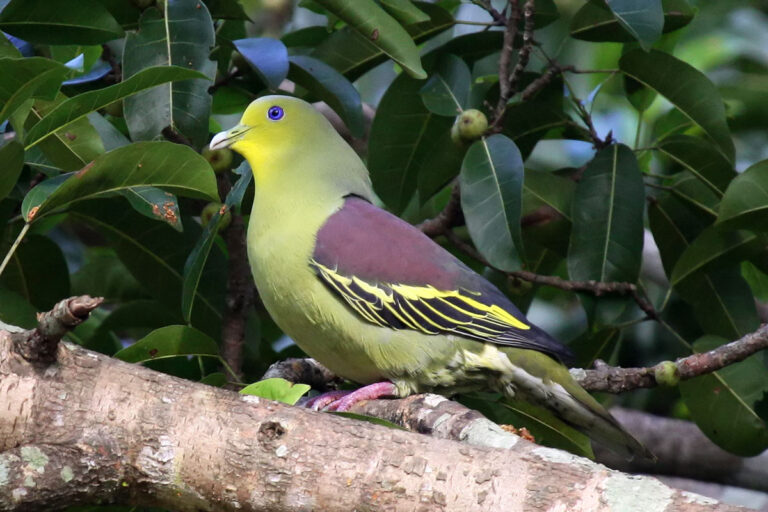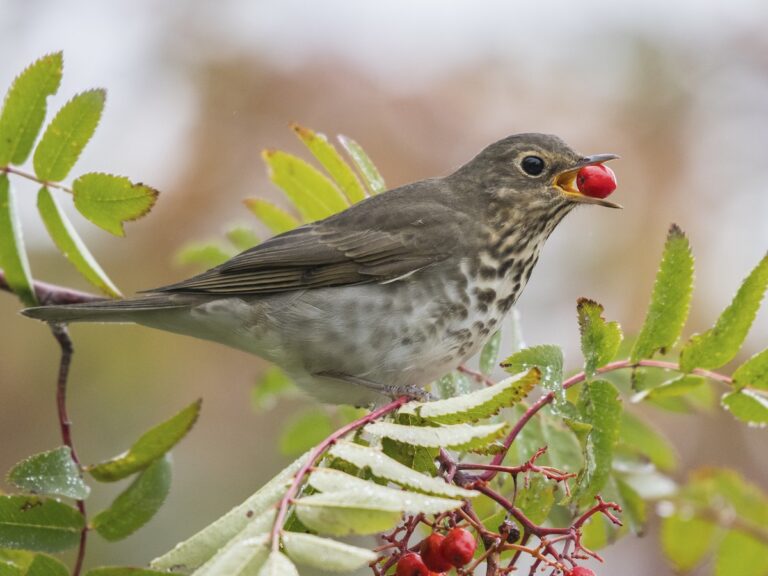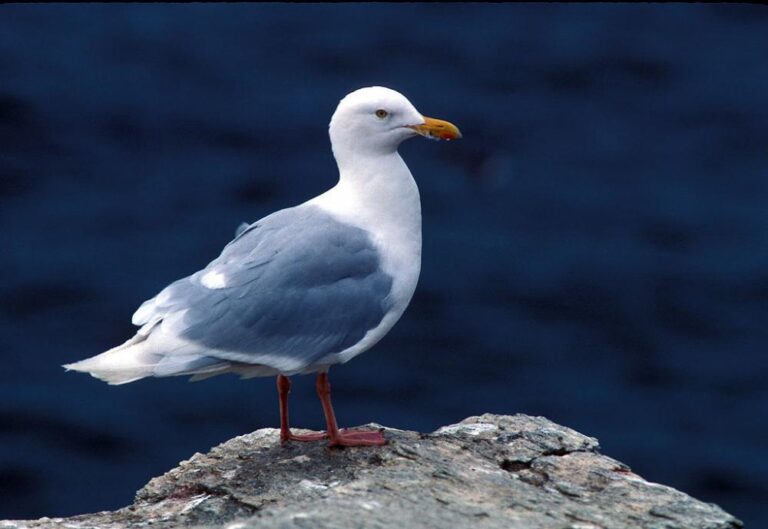Top 10 Small Birds with Red Beaks (ID Guide With Pictures)
Exploring Small Birds with Red Beaks is fascinating. These birds stand out with their bright beaks, which are not just for looks; they help them survive and thrive.
For bird lovers, small birds with red beaks are a delight. Their colors tell us about their habits and homes, and learning about these birds helps us understand their role in nature.
The Importance of Beak Color in Bird Identification
Knowing about beak color is key to spotting small birds. It tells us about their health and what they eat. A bird’s beak color shows if it is healthy and what it eats. Bright red beaks mean the bird is fit, thanks to a diet full of carotenoids or porphyrins.
These pigments change the beak’s color. This shows how important beak color is for watching birds and checking their health.
Health Indicators of Red Beaks
The color of a bird’s beak can tell us a lot about its health. A bright red beak means the bird is healthy. It shows the bird eats well and is disease-free.
This color comes from eating foods full of important nutrients. Some signs of good health include:
- Vibrancy of color
- Color consistency
- The presence of sheen or gloss
Dietary Influence on Beak Color
What a bird eats affects its beak color. Foods high in carotenoids, like fruits and veggies, make beaks brighter. Not eating right can make beaks duller.
Here’s a table showing how different foods change beak color:
| Food Type | Influence on Beak Color |
|---|---|
| Carrots | Increases orange/red pigmentation |
| Spinach | Enhances green hues |
| Berries | Rich in red pigments, improves brightness |
| Seeds | Contributes to overall subtle tones |
1. Northern Cardinal
The Northern Cardinal is known for its bright red color and black mask. It lives mainly in eastern and central North America. Knowing where it lives and what it eats makes it even more interesting.
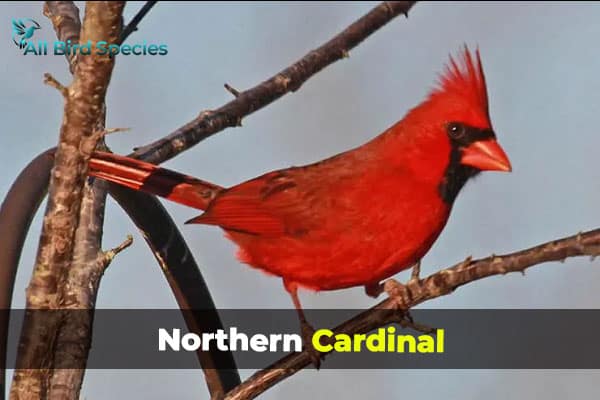
Habitat and Distribution
This bird likes different places, such as:
- Woodlands
- Parks
- Suburban areas
It can be found in many states, like:
- Virginia
- Texas
- Illinois
These places offer good homes and places to nest. This makes them great for watching birds in your backyard.
Diet and Feeding Habits
Northern Cardinals eat a variety of foods, including:
- Seeds
- Fruits
- Insects
They love visiting bird feeders in gardens. They eat sunflower seeds and other mixes, and their flexible eating habits help them live well in many places.
2. Black Oystercatcher
The Black Oystercatcher is a standout coastal bird. Its shiny black feathers and bright red beak make it a favorite among bird watchers.
This bird lives in places full of sea life. Its behavior reveals a lot about its life and habits.
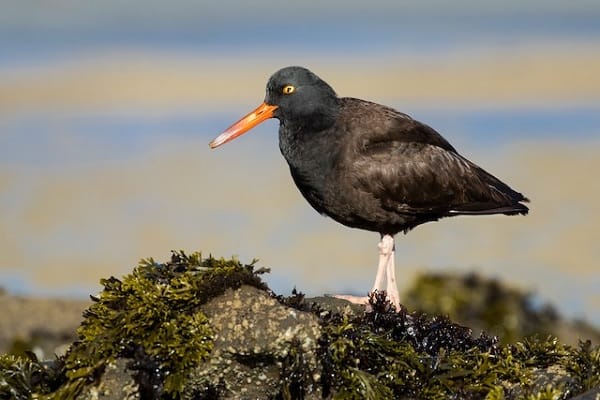
Distinctive Features
The Black Oystercatcher’s red beak is very noticeable. It stands out against its dark feathers. Other key features include:
- Yellow eyes help it find food.
- Pale pink legs that add to its look.
- Long wings for flying over the coast.
Feeding Preferences
Black Oystercatchers mainly eat mollusks and sea creatures. They use their beaks to open shells on rocky shores. This helps keep the coast healthy.
Here’s what they like to eat:
| Food Type | Examples | Feeding Technique |
|---|---|---|
| Mollusks | Clams, Oysters | Prying open shells |
| Marine Invertebrates | Crabs, Sea Urchins | Foraging in tidal pools |
| Soft-bodied Organisms | Worms, Shrimp | Snapping and pecking |
3. Red-billed Chough
The Red-billed Chough is a fascinating bird. It has a striking red beak and loves to be around others. Its love for certain places and foods shows how it fits into its world.

Habitat Preferences
This bird loves mountains and rocky places. It finds great spots to look for food and build homes. It likes open areas, flying over cliffs and meadows. Where it lives affects how it acts and who it hangs out with.
Diet Overview
The Red-billed Chough eats insects, seeds, and berries. It can change what it eats based on its surroundings. By eating in different places, it helps spread seeds and control pests. This keeps its home healthy.
| Aspect | Details |
|---|---|
| Scientific Name | Pyrrhocorax pyrrhocorax |
| Habitat Type | Mountains, rocky terrains |
| Diet | Insects, seeds, berries |
| Social Behavior | Highly social, often found in groups |
| Ecological Role | Seed dispersal, pest control |
4. Red-billed Tropicbird
The Red-billed Tropicbird is truly amazing. It has long tail feathers and a bright red bill. It lives on rocky islands, making it special in the sea.
They have interesting Breeding Behavior. Every year, they return to the same place to mate and care for their young. Their looks and life cycles make them very interesting.
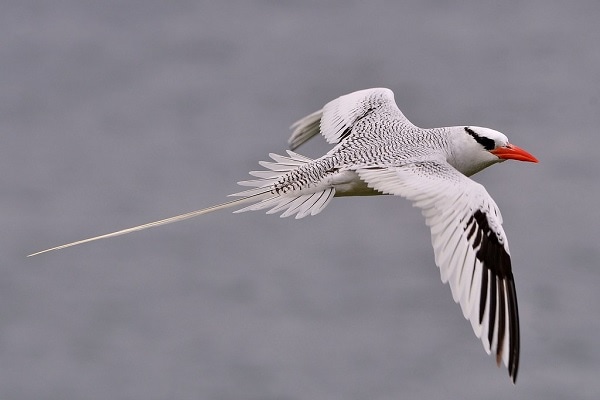
Breeding and Lifecycles
When it’s time to breed, Red-billed Tropicbirds show off in courtship. They form pairs and nest on cliffs or grassy slopes. The female lays one egg, and both parents take turns incubating it.
They care for their chick for months until it can fly independently. This shows how strong their pair bonds are. It’s a big part of seabird life.
Foraging Behavior
Red-billed Tropicalbirds spend a lot of time hunting in the ocean. They look for fish and squid, and they dive deep to catch their food, showing how skilled they are at it.
They need healthy oceans to survive. This highlights the need to protect our seas for these amazing birds.
5. Green Wood Hoopoe
The Green Wood Hoopoe is known for its bright colors and long, curved red beak. It lives in groups, showing how social birds work together, which helps us understand its unique way of life.
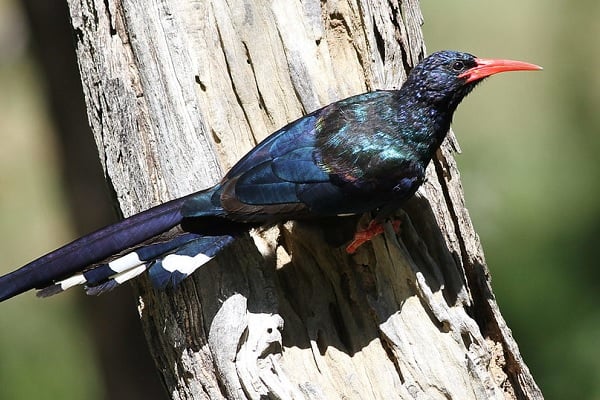
Preferred Habitats
Green Wood Hoopoes love certain places to live. They like:
- Woodlands with tall trees
- Riverine forests near water sources
- Open savannahs that offer suitable nesting sites
These places give them what they need and help them meet each other.
Group Behavior
Green Wood Hoopoes are very social. They hunt together, looking for insects and other food. This way, they all have a better chance to survive. Their social life includes:
- Joint foraging to locate food more efficiently
- Common nesting sites that strengthen social bonds
- Collaborative defense against potential predators
6. Rose-ringed Parakeet
The Rose-ringed Parakeet is known for its bright green feathers and red beak. It lives in many places, showing it can adapt well.

Native Range and Habitats
The Rose-ringed Parakeet lives in warm and mild places. It likes:
- Woodlands and forests
- Urban areas and parks
- Open grasslands and savannas
This bird is found all over the world. It’s very good at living in different places.
Dietary Lifestyles
The Rose-ringed Parakeet eats many things. It likes:
- Seeds
- Nuts
- Fruits and berries
This helps it live well in many places. It’s good for the environment too.
| Dietary Items | Nutritional Benefits |
|---|---|
| Seeds | High in carbohydrates and fiber |
| Nuts | Rich in healthy fats and protein |
| Fruits | Source of vitamins and hydration |
7. Black Stork
The Black Stork is known for its beautiful looks and interesting behaviors. It travels long distances between its breeding and wintering grounds. Its Migration patterns show how healthy the areas it visits are.
![]()
Migration Patterns
In the breeding season, the Black Stork likes wetlands in Europe and Asia. These places are great for nesting. When winter comes, it travels to warm places, facing dangers along the way.
This journey is key for the birds’ social lives and survival.
Feeding Techniques
The Feeding Behavior of the Black Stork is fascinating. It catches fish and amphibians in shallow water. It uses its long, sharp bill to spear its prey.
This hunting helps keep wetland ecosystems balanced. It shows the Black Stork’s important role as a predator.
8. Common Waxbill
The Common Waxbill is a delightful member of the small finches family. It is loved by bird watchers and nature enthusiasts. Its vibrant plumage, mainly shades of reddish-brown, makes it a joy to see. Its small size and active nature make it a favorite among bird watchers.

The Common Waxbill lives in grasslands and wetlands where seeds and small insects are common. Because of its sociable nature, it is often seen in flocks, which are lively and engaging, making it interesting to watch.
Thanks to its physical characteristics, identifying the common waxbill is easy. Its red bill is matched by delicate, intricate markings on its body. This mix of colors and patterns makes it stand out as one of the most delightful small finches.
If you want to enhance your bird-watching experience, look for Common Waxbills. Watching these small finches in their flocks is exciting, and it allows you to appreciate their behaviors and habitats.
9. Grey-headed Kingfisher
The Grey-headed Kingfisher is a vibrant bird that catches the eye. It has rich blues, yellows, and a grey head. These birds live in Africa, near water where they can find food.
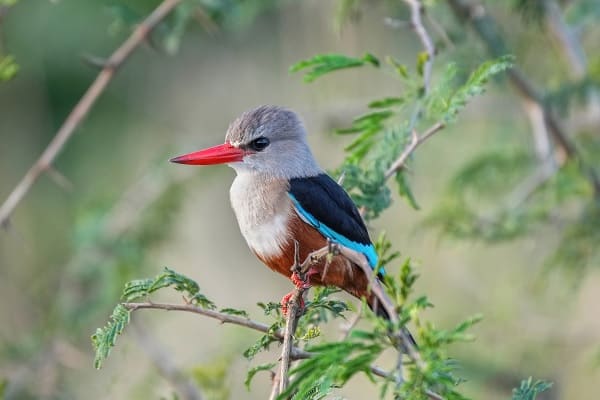
This bird is important for bird diversity. It hunts insects with skill and speed. It spots prey from a perch and then dives down to catch it.
Knowing about the Grey-headed Kingfisher shows its role in nature. It helps keep insect numbers in check. Watching them shows us how nature works and why we should protect these birds.
| Characteristic | Description |
|---|---|
| Coloration | Bright blues and yellows with a grey head |
| Diet | Mainly insects |
| Habitat | Near water bodies across Africa |
| Hunting Technique | Swoops from perches to catch prey |
| Ecological Role | Controls insect populations |
The Grey-headed Kingfisher is more than just a pretty sight. It shows the beauty of bird diversity. By learning about it, we can better appreciate and protect our natural world.
10. African Swamphen
The African Samphen is a colorful bird with a bright red beak. It thrives in many different spots because it lives in places that meet its needs.
Habitat Preferences
This bird loves wetlands, like marshes and flooded places. It needs lots of plants for cover and to build nests. The African Swamphen can live in both natural and man-made water areas.
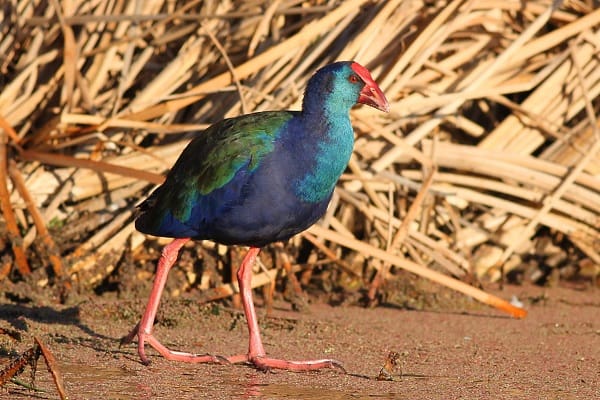
Dietary Choices
The African Shaman eats seeds, leaves, roots, and small animals like insects and crustaceans. This shows that it can find food in wetlands and is very good at it.
| Aspect | Details |
|---|---|
| Habitat Type | Wetlands, Marshes, Flooded Areas |
| Diet | Plant Material, Insects, Crustaceans |
| Adaptability | Natural & Man-Made Aquatic Ecosystems |
11. Red-breasted Merganser Duck
The Red-breasted Merganser is a unique diving duck. It has a shaggy crest and a bright red beak. These features make it a favorite among birdwatchers.
Distinctive Features
The Red-breasted Merganser has a long body and a slender shape. It has:
- Shaggy crest on the back of its head.
- Bright red bill perfect for catching fish.
- Dark green head with a white neck ring and gray body.
These traits help it hunt better as a diving duck.

Seasonal Behavior
This duck has interesting seasonal habits, especially during migration. Every year, they travel long distances to their breeding and feeding spots. Key points include:
- They migrate in early spring and late fall.
- They like shallow coastal waters and inland lakes for nesting.
- They mainly eat fish and crustaceans, showing off their diving skills.
This eating habit helps keep aquatic ecosystems healthy. It lets them live well in their natural homes.
12. Red-billed Oxpecker
The Red-billed Oxpecker is special because of its unique behavior and how it works with big animals. It eats parasites from its hosts, helping both of them. This shows how animals can work together in a special way.
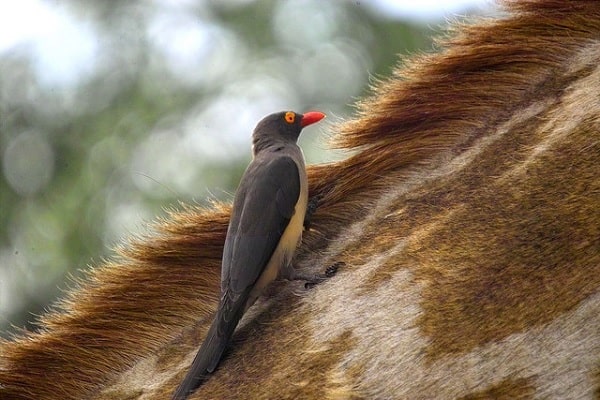
Behavior with Hosts
The Red-billed Oxpecker has interesting ways of working with its hosts. It jumps on big animals like buffalo and giraffes. There, it picks off ticks and other pests.
This helps the bird get food and helps the animal by keeping it healthy. The bird’s actions are key to its relationship with its hosts.
- Vocal Communication: These birds make loud sounds while they’re with their hosts.
- Preening Behavior: They clean their hosts to find parasites more easily.
- Accessibility to multiple hosts: One oxpecker can visit many animals in a day, showing it’s very flexible.
The Red-billed Oxpecker’s special way of eating shows its big role in nature. It keeps animals healthy by controlling pests. This makes it a standout bird that we should all appreciate.
13. White Ibis
The White Ibis is easy to spot in shallow waters. It has white feathers and a long red beak. It lives in wetlands, estuaries, and marshes. Knowing where it lives and nests helps us appreciate it more.
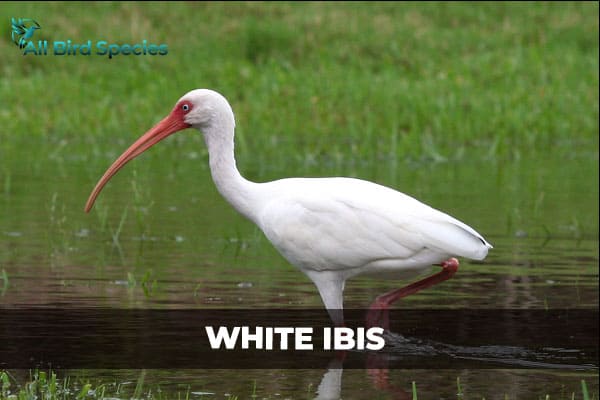
Habitat and Nesting
White Ibises like places with lots of water. They nest in low shrubs or trees near water. Their nests are built for safety and to raise their young.
- Availability of food: They eat crustaceans, insects, and small fish. They pick places with lots of food.
- Protection from predators: They choose safe spots to nest. This is important when they are breeding.
- Social structure: They nest together. This helps keep their young safe.
White Ibises do more than look good. They help keep their homes healthy by eating insects and helping with nutrients. Watching them shows us how wetlands work.
| Feature | Description |
|---|---|
| Coloration | White plumage with distinctive red beak |
| Habitat | Wetlands, estuaries, marshes |
| Nesting Behavior | Build nests in low shrubs or trees near water |
| Diet | Crustaceans, insects, small fish |
Common Characteristics of Small Birds with Red Beaks
Knowing the Common Bird Characteristics of small birds with red beaks is key. These birds have special Physical Features that make them stand out. Spotting these traits helps us tell one bird from another.
Physical Features of Small Birds
Small birds with red beaks have many interesting Physical Features. These include:
- Color Variations: They often have bright colors that match their red beaks.
- Size: These birds are usually small, which helps them move fast and live in many places.
- Beak Shape: Their beaks are shaped for their eating habits, like drinking nectar or eating seeds.
Behavioral Traits
Small birds with red beaks also have unique Behavioral Patterns. These patterns show how they live their daily lives:
- Social Interactions: Many birds like to be together, whether they’re looking for food or building nests.
- Feeding Techniques: They eat in different ways, like sucking nectar from flowers or breaking open seeds.
- Nesting Practices: How they build nests varies, with some making complex nests in trees and others nesting on the ground.
Looking at these Common Bird Characteristics deepens our understanding of their roles in nature. It also shows how they adapt to their environments.
Bottom Line
Exploring small birds with red beaks is truly captivating. It shows us a world full of beauty and diversity. Birds like the Northern Cardinal and the Green Wood Hoopoe are amazing.
Their red beaks are not just pretty. They also tell us about their health and what they eat. This helps them survive in their homes.
Watching and learning about birds helps protect them. Caring for these birds helps keep our world beautiful so future generations can also enjoy it.
The adventure of learning about small birds with red beaks is just starting. Let’s dive deeper into their world. Join local efforts to save these birds and share your love for them with others. Every little bit helps to keep their charm alive.

